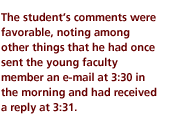
Dean's Column
By Dean Samuel H. Preston
Doing Time In Academia
 Many
people today have the impression that, with summers "off" and
"only" four or so classes to teach, the scholarly life is a
leisurely one. In fact, university professors experience time much the
same as race-car drivers experience speed: There is never enough of it.
Many
people today have the impression that, with summers "off" and
"only" four or so classes to teach, the scholarly life is a
leisurely one. In fact, university professors experience time much the
same as race-car drivers experience speed: There is never enough of it.
A 2001 campus survey found that Penn faculty members work an average of 59 hours a week. The U.S. Department of Labor’s Current Population Survey puts a 59-hour workweek in the top five percent of all American workers. An earlier national survey showed that chemists worked the longest hours and mathematicians the shortest, an ordering that may reflect their different positions along the perspiration-inspiration continuum.
Given the way universities are structured, academics are essentially CEOs, more like independent entrepreneurs running their own projects and activities than members of a highly integrated team. Perhaps the analogy explains why a recent Inc Magazine survey found that on average Inc 500 CEOs work 58 hours a week—very close to the typical workweek for Penn faculty.
 A
university professor follows two rhythms in his or her life: one is the
academic calendar with its teaching demands; the other is the calendar
of scholarly research and presentation. Many of the professional societies
for academics schedule conferences to take advantage of gaps in the academic
calendar. The American Economic Association, for instance, meets over
the break between fall and spring semesters, while the American Sociological
Association convenes in the summer. Typically, professors commit themselves
to presenting conference papers they haven’t even begun.
A
university professor follows two rhythms in his or her life: one is the
academic calendar with its teaching demands; the other is the calendar
of scholarly research and presentation. Many of the professional societies
for academics schedule conferences to take advantage of gaps in the academic
calendar. The American Economic Association, for instance, meets over
the break between fall and spring semesters, while the American Sociological
Association convenes in the summer. Typically, professors commit themselves
to presenting conference papers they haven’t even begun.
Some workdays can stretch to extremes. Last year, while reviewing the performance of an assistant professor who was being considered for promotion, I read a letter from a student who had taken a course with the candidate. The student’s comments were favorable, noting among other things that he had once sent the young faculty member an e-mail at 3:30 in the morning and had received a reply at 3:31.
University faculty are a driven lot, driven by a love of their discipline, by devotion to their students, and, yes, by personal ambition. There is an incessant pressure, a persistent sense that there is more to be done. Without such drive, one cannot keep up with advances in one’s field. Achieving tenure at a major research university requires nearly full effort nearly all the time, and maintaining the respect of colleagues, post-tenure, requires the same degree of effort.
As the end of spring semester approaches, the calendar for most faculty becomes crowded with a crescendo of obligations. Students are submitting final papers, dissertations, and exams, and faculty must testify to their achievement according to the registrar’s immutable timetable. Faculty committees are busy writing final reports. New faculty members are being considered for positions, and talented professors with offers from elsewhere must be courted anew. The next graduate student body is being admitted, and the search is on for next year’s funding for all graduate students.
But mental equilibrium is restored in May, when our purposes are so movingly revealed in caps and gowns. We labor mightily, but we are also immensely privileged.